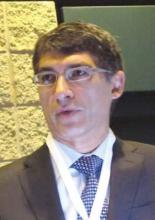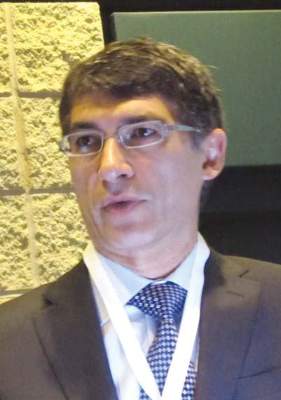User login
A 12-week course of oral daclatasvir, asunaprevir, and beclabuvir, with or without ribavirin, achieved a sustained virologic response (SVR) in patients with hepatitis C, judging from the findings of two studies.
In the first open-label study (UNITY-1), 312 treatment-naive and 103 treatment-experienced cirrhosis-free patients with chronic infection with hepatitis C virus (HCV) genotype 1 were treated with an oral fixed-dose regimen of daclatasvir, asunaprevir, and beclabuvir for 12 weeks, reported Dr. Andrew J. Muir of Duke Clinical Research Institute, Durham, N.C., and his associates.
Overall, 91.3% of patients achieved an SVR at 12 weeks (HCV-RNA < 25 IU/mL) after treatment cessation, with a slightly greater response among treatment-naive patients, compared with treatment-experienced patients (92% vs. 89.3%), according to a paper published May 5 in JAMA.
HCV treatment regimens are evolving rapidly away from interferon-based regimens toward all-oral antiviral regimens, such as the one used in this study, according to the investigators.
Daclatasvir inhibits the HCV NS5A protein, asunaprevir is an NS3 protease inhibitor with activity against genotypes 1 and 4.5, and beclabuvir is a nonnucleoside NS5B inhibitor.
Patients with genotype 1b showed higher response rates than those with genotype 1a in both the treatment-experienced and treatment-naive cohorts (JAMA 2015;313:1728-35 [doi:10.1001/jama.2015.3860]).
The second study (UNITY-2) involved 112 treatment-naive and 90 treatment-experienced patients with HCV and compensated cirrhosis, also treated with daclatasvir, asunaprevir, and beclabuvir.
However in this study, published in the same edition of JAMA, the patients were also randomized to double-blinded, weight-based ribavirin (1000-1200 mg/day) or placebo (JAMA 2015;313:1736-44 [doi:10.1001/jama.2015.3868]).
Among the treatment-naive group, 98% of patients also treated with ribavirin achieved an SVR at 12 weeks, while the response rate for treatment alone was 93%.
The response rate was 93% among treatment-experienced patients also given ribavirin and 87% among those given treatment alone.
The authors of the UNITY-2 study said patients with cirrhosis often experienced problems with peginterferon-based treatment regimens because of reduced response rates and more frequent and severe adverse events, hence the interest in interferon-free treatment options.
Both studies observed treatment-emergent alanine aminotransferase elevations – two cases in UNITY-1 and four cases in UNITY-2 – but only UNITY-2 recorded treatment-related adverse events, including anemia, aminotransferase and bilirubin elevations, and ribavirin overdose.
The UNITY-2 study also recorded grade 3 or 4 hemoglobin abnormalities in 5% of patients taking ribavirin but none in the treatment-only group.
Researchers on UNITY-1 said the response rates they observed in their study group were comparable to those seen in other phase III studies of all-oral direct-acting antiviral regimens, such as the fixed-dose combinations of sofosbuvir and ledipasvir and ABT-450/ritonavir, ombitasvir, dasabuvir, and ribavirin.
“Furthermore, SVR12 rates in this study were consistently high across baseline subgroups of patients, including sex, age, HCV-RNA level, and IL28B genotype, suggesting that this regimen has the potential to be broadly effective across genotype 1 patient populations,” wrote Dr. Fred Poordad of the University of Texas Health Science Center at San Antonio and his associates in the UNITY-1 study.
They qualified this by pointing out that the study included relatively few patients of black race – as did UNITY-2 – although the response rates were still high among this group.
Both studies were funded by Bristol-Myers Squibb. Many authors reported personal fees, grants, and speaking engagements from the pharmaceutical industry, including Bristol-Myers Squibb, and several authors were employees of Bristol-Myers Squibb.
These two studies add to the armamentarium of all-oral IFN-free regimens that have revolutionized the management of hepatitis C virus infection, not only for patients who are treatment naive with no significant liver disease but also for those who are treatment experienced and those with cirrhosis.
 |
Dr. Hari Conjeevaram |
However questions still remain about the response rate based on race, access to, and affordability of these therapies, improvements in quality of life, cost-effectiveness, and their use in difficult-to-treat situations such as patients with end-stage liver disease or those undergoing hemodialysis.
Hepatitis C is a global disease and although substantial progress has been made in HCV eradication, the success of such progress will be defined not just by the SVR rates but by accessibility and affordability of these medications.
Dr. Hari Conjeevaram is from the division of gastroenterology at the University of Michigan. These comments are taken from an accompanying editorial (JAMA 2015 May 5 [doi:10.1001/jama.2015.4368]. No conflicts of interest were declared.
These two studies add to the armamentarium of all-oral IFN-free regimens that have revolutionized the management of hepatitis C virus infection, not only for patients who are treatment naive with no significant liver disease but also for those who are treatment experienced and those with cirrhosis.
 |
Dr. Hari Conjeevaram |
However questions still remain about the response rate based on race, access to, and affordability of these therapies, improvements in quality of life, cost-effectiveness, and their use in difficult-to-treat situations such as patients with end-stage liver disease or those undergoing hemodialysis.
Hepatitis C is a global disease and although substantial progress has been made in HCV eradication, the success of such progress will be defined not just by the SVR rates but by accessibility and affordability of these medications.
Dr. Hari Conjeevaram is from the division of gastroenterology at the University of Michigan. These comments are taken from an accompanying editorial (JAMA 2015 May 5 [doi:10.1001/jama.2015.4368]. No conflicts of interest were declared.
These two studies add to the armamentarium of all-oral IFN-free regimens that have revolutionized the management of hepatitis C virus infection, not only for patients who are treatment naive with no significant liver disease but also for those who are treatment experienced and those with cirrhosis.
 |
Dr. Hari Conjeevaram |
However questions still remain about the response rate based on race, access to, and affordability of these therapies, improvements in quality of life, cost-effectiveness, and their use in difficult-to-treat situations such as patients with end-stage liver disease or those undergoing hemodialysis.
Hepatitis C is a global disease and although substantial progress has been made in HCV eradication, the success of such progress will be defined not just by the SVR rates but by accessibility and affordability of these medications.
Dr. Hari Conjeevaram is from the division of gastroenterology at the University of Michigan. These comments are taken from an accompanying editorial (JAMA 2015 May 5 [doi:10.1001/jama.2015.4368]. No conflicts of interest were declared.
A 12-week course of oral daclatasvir, asunaprevir, and beclabuvir, with or without ribavirin, achieved a sustained virologic response (SVR) in patients with hepatitis C, judging from the findings of two studies.
In the first open-label study (UNITY-1), 312 treatment-naive and 103 treatment-experienced cirrhosis-free patients with chronic infection with hepatitis C virus (HCV) genotype 1 were treated with an oral fixed-dose regimen of daclatasvir, asunaprevir, and beclabuvir for 12 weeks, reported Dr. Andrew J. Muir of Duke Clinical Research Institute, Durham, N.C., and his associates.
Overall, 91.3% of patients achieved an SVR at 12 weeks (HCV-RNA < 25 IU/mL) after treatment cessation, with a slightly greater response among treatment-naive patients, compared with treatment-experienced patients (92% vs. 89.3%), according to a paper published May 5 in JAMA.
HCV treatment regimens are evolving rapidly away from interferon-based regimens toward all-oral antiviral regimens, such as the one used in this study, according to the investigators.
Daclatasvir inhibits the HCV NS5A protein, asunaprevir is an NS3 protease inhibitor with activity against genotypes 1 and 4.5, and beclabuvir is a nonnucleoside NS5B inhibitor.
Patients with genotype 1b showed higher response rates than those with genotype 1a in both the treatment-experienced and treatment-naive cohorts (JAMA 2015;313:1728-35 [doi:10.1001/jama.2015.3860]).
The second study (UNITY-2) involved 112 treatment-naive and 90 treatment-experienced patients with HCV and compensated cirrhosis, also treated with daclatasvir, asunaprevir, and beclabuvir.
However in this study, published in the same edition of JAMA, the patients were also randomized to double-blinded, weight-based ribavirin (1000-1200 mg/day) or placebo (JAMA 2015;313:1736-44 [doi:10.1001/jama.2015.3868]).
Among the treatment-naive group, 98% of patients also treated with ribavirin achieved an SVR at 12 weeks, while the response rate for treatment alone was 93%.
The response rate was 93% among treatment-experienced patients also given ribavirin and 87% among those given treatment alone.
The authors of the UNITY-2 study said patients with cirrhosis often experienced problems with peginterferon-based treatment regimens because of reduced response rates and more frequent and severe adverse events, hence the interest in interferon-free treatment options.
Both studies observed treatment-emergent alanine aminotransferase elevations – two cases in UNITY-1 and four cases in UNITY-2 – but only UNITY-2 recorded treatment-related adverse events, including anemia, aminotransferase and bilirubin elevations, and ribavirin overdose.
The UNITY-2 study also recorded grade 3 or 4 hemoglobin abnormalities in 5% of patients taking ribavirin but none in the treatment-only group.
Researchers on UNITY-1 said the response rates they observed in their study group were comparable to those seen in other phase III studies of all-oral direct-acting antiviral regimens, such as the fixed-dose combinations of sofosbuvir and ledipasvir and ABT-450/ritonavir, ombitasvir, dasabuvir, and ribavirin.
“Furthermore, SVR12 rates in this study were consistently high across baseline subgroups of patients, including sex, age, HCV-RNA level, and IL28B genotype, suggesting that this regimen has the potential to be broadly effective across genotype 1 patient populations,” wrote Dr. Fred Poordad of the University of Texas Health Science Center at San Antonio and his associates in the UNITY-1 study.
They qualified this by pointing out that the study included relatively few patients of black race – as did UNITY-2 – although the response rates were still high among this group.
Both studies were funded by Bristol-Myers Squibb. Many authors reported personal fees, grants, and speaking engagements from the pharmaceutical industry, including Bristol-Myers Squibb, and several authors were employees of Bristol-Myers Squibb.
A 12-week course of oral daclatasvir, asunaprevir, and beclabuvir, with or without ribavirin, achieved a sustained virologic response (SVR) in patients with hepatitis C, judging from the findings of two studies.
In the first open-label study (UNITY-1), 312 treatment-naive and 103 treatment-experienced cirrhosis-free patients with chronic infection with hepatitis C virus (HCV) genotype 1 were treated with an oral fixed-dose regimen of daclatasvir, asunaprevir, and beclabuvir for 12 weeks, reported Dr. Andrew J. Muir of Duke Clinical Research Institute, Durham, N.C., and his associates.
Overall, 91.3% of patients achieved an SVR at 12 weeks (HCV-RNA < 25 IU/mL) after treatment cessation, with a slightly greater response among treatment-naive patients, compared with treatment-experienced patients (92% vs. 89.3%), according to a paper published May 5 in JAMA.
HCV treatment regimens are evolving rapidly away from interferon-based regimens toward all-oral antiviral regimens, such as the one used in this study, according to the investigators.
Daclatasvir inhibits the HCV NS5A protein, asunaprevir is an NS3 protease inhibitor with activity against genotypes 1 and 4.5, and beclabuvir is a nonnucleoside NS5B inhibitor.
Patients with genotype 1b showed higher response rates than those with genotype 1a in both the treatment-experienced and treatment-naive cohorts (JAMA 2015;313:1728-35 [doi:10.1001/jama.2015.3860]).
The second study (UNITY-2) involved 112 treatment-naive and 90 treatment-experienced patients with HCV and compensated cirrhosis, also treated with daclatasvir, asunaprevir, and beclabuvir.
However in this study, published in the same edition of JAMA, the patients were also randomized to double-blinded, weight-based ribavirin (1000-1200 mg/day) or placebo (JAMA 2015;313:1736-44 [doi:10.1001/jama.2015.3868]).
Among the treatment-naive group, 98% of patients also treated with ribavirin achieved an SVR at 12 weeks, while the response rate for treatment alone was 93%.
The response rate was 93% among treatment-experienced patients also given ribavirin and 87% among those given treatment alone.
The authors of the UNITY-2 study said patients with cirrhosis often experienced problems with peginterferon-based treatment regimens because of reduced response rates and more frequent and severe adverse events, hence the interest in interferon-free treatment options.
Both studies observed treatment-emergent alanine aminotransferase elevations – two cases in UNITY-1 and four cases in UNITY-2 – but only UNITY-2 recorded treatment-related adverse events, including anemia, aminotransferase and bilirubin elevations, and ribavirin overdose.
The UNITY-2 study also recorded grade 3 or 4 hemoglobin abnormalities in 5% of patients taking ribavirin but none in the treatment-only group.
Researchers on UNITY-1 said the response rates they observed in their study group were comparable to those seen in other phase III studies of all-oral direct-acting antiviral regimens, such as the fixed-dose combinations of sofosbuvir and ledipasvir and ABT-450/ritonavir, ombitasvir, dasabuvir, and ribavirin.
“Furthermore, SVR12 rates in this study were consistently high across baseline subgroups of patients, including sex, age, HCV-RNA level, and IL28B genotype, suggesting that this regimen has the potential to be broadly effective across genotype 1 patient populations,” wrote Dr. Fred Poordad of the University of Texas Health Science Center at San Antonio and his associates in the UNITY-1 study.
They qualified this by pointing out that the study included relatively few patients of black race – as did UNITY-2 – although the response rates were still high among this group.
Both studies were funded by Bristol-Myers Squibb. Many authors reported personal fees, grants, and speaking engagements from the pharmaceutical industry, including Bristol-Myers Squibb, and several authors were employees of Bristol-Myers Squibb.
FROM JAMA
Key clinical point: A 12-week course of oral daclatasvir, asunaprevir, and beclabuvir, with or without ribavirin achieves a high response rate in patients with hepatitis C.
Major finding: More than nine out of ten treatment-naive or treatment-experienced patients achieved a sustained virologic response at 12 weeks.
Data source: Two prospective, open-label, nonrandomized studies, the first in 415 cirrhosis-free patients with HCV, and the second in 202 patients with cirrhosis and HCV.
Disclosures: Both studies were funded by Bristol-Myers Squibb. Many authors reported personal fees, grants, and speaking engagements from the pharmaceutical industry, including Bristol-Myers Squibb, and several authors were employees of Bristol-Myers Squibb.

